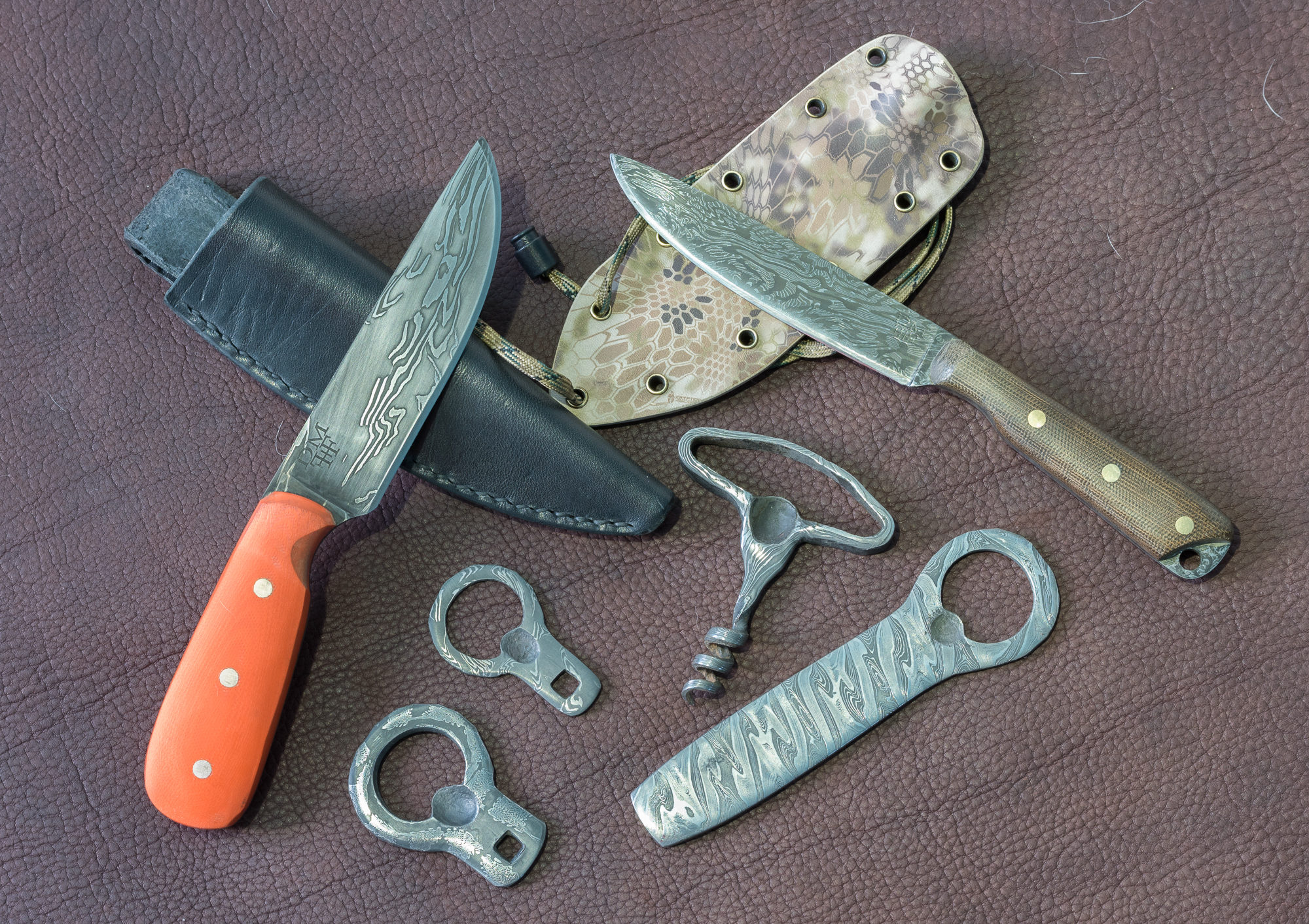Now that the steel is annealed, this is the best time to grind, drill, file etc., while the steel is in a softer, machineable state.
Anti-Scale
After grinding, drilling, etc., the steel is soaked for another 10-15 minutes at 500 F and anti-scale compound is applied again to prevent decarb during the long austening soak. Often I’ll only coat the business end with anti-scale as I’m not as concerned with some decarb on the handle.
Austenizing and the Quench
After anti-scale is applied, the steel goes back in the HT oven and temp is ramped up to 1475 F. The steel is soaked for 10 min once the HT oven hits temperature, and then is quickly quenched in warm (generally 65-110 F) Parks 50 oil, agitating the steel up and down. Parks 50 is a fast quench oil meant to mimic water quenching with less stress and warpage. In winter, when the oil is 20-30 F, I use an engine block heater to warm up the oil to recommended temperature, and occasionally in the summer I’ll use old blue ice packs to cool the oil if it’s too hot. If you see lots of flames during the quench, then you’re breaking down your oil. Quench oil isn’t cheap but will last a long time if used properly.



Warpage
Straight out of the quench, the steel will frequently be warped. I generally keep the steel in the oil for 7-10 seconds and when it comes out, it’s hot enough to be straightened by hand, or in a post vise (or post vise with aluminum quench plates). Funny that sometimes I can see the warpage in the steel, and seconds later it will bend back to straight all on it’s own (or warp the other way if you correct it).


The thinner the steel, the more it tends to warp. If a blade is still warped by the time it has cooled down to 200 F or so, then I generally re-quench rather than attempting to re-bend during tempering or cold working. I’ve never had a blade crack or break during quench, but I have lost several trying to re-straighten during tempering.
Once the steel is cooled to 150-200 F, I put the steel in boiling water to remove the anti-scale compound, and then it goes straight into the toaster oven for snap tempering.


Snap Temper
This is an important part of the process that is sometimes overlooked. HT ovens heat up much faster than they cool down… One way to avoid the need for snap tempering is to have a second HT oven dedicated to tempering to avoid waiting for cooldown. I snap temper at approximately 325 F in a toaster oven while the HT oven cools. This generally takes about an hour. This is to avoid potential cracks that occur if a quenched blade is allowed to cool to room temperature. Just because you don’t have cracks after quench doesn’t mean they won’t appear later if you leave the blade cool before tempering (this is a major flaw/issue in a popular tv show…) Once the HT oven has cooled, the steel is removed from the toaster oven and cooled in water before heading back to the HT oven for proper tempering.

Tempering
Tempering is the part of the process where I have enough time to do other things away from the shop. The HT oven is set for 375 F (kitchen and EDC blades) or 425 F (hard use blades, hoof picks, golf tools) and the steel is soaked for 2 hours time. Then the steel is cooled off in water and the same tempering procedure is repeated.

Hardness Testing
Now the steel is ready for final grinding, hardness testing, hand sanding, etch, handles etc… I haven’t been able to justify a proper Rockwell hardness tester, but there are alternative that can work well if you know how to use them properly. Files and chisels of known hardness work well. I have a set of chisels and these are what I’d strongly recommend over files. The idea is to try to scratch the steel in question with the files – if the file/chisel is harder, the steel scratches, if the steel is harder, the file/chisel dulls. Yes, it DULLS, that means once you use it and dull it, it needs to be sharpened again if you want a valid test. Chisels are easy to keep sharp, removing minimal material, with a sharpening stone. Files… not so much. Before putting the final edge on the blade, I also test by shaving pieces of steel off a welding table I have nearby.
If all of the equipment is working properly but part or all of the steel surface isn’t hardening, decarb is likely the issue. This can be verified by a quick etch in ferric chloride.
A good reality check in addition to hardness is breaking a sample piece of steel that was heat treated with everything else to analyze the grain size.

Remember, all of this is specific to 1095 and 1095/15N20 Damascus steel. Other steels generally will have different processes to optimize the final properties of the steel via heat treatment.
